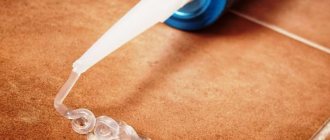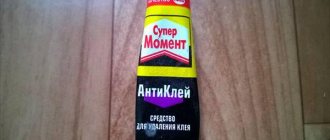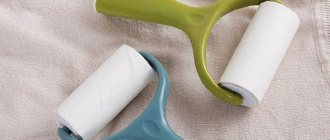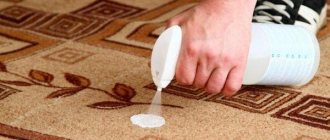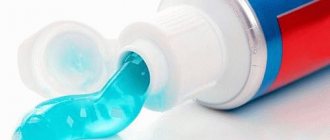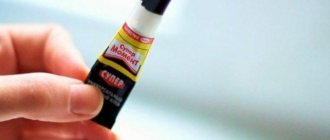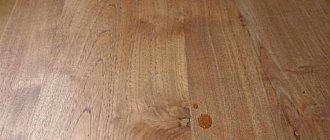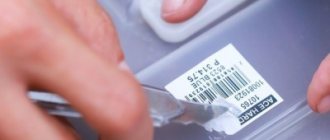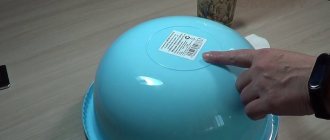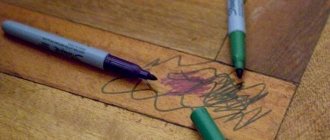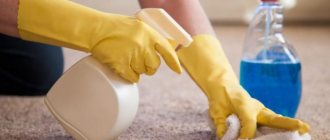Difficulty removing glue
“Moment” received its name for a reason - this adhesive composition is instant in setting, quick-drying and very durable. In a few seconds, the glue impregnates the fibers of loose material or firmly adheres to a dense base. This effect is achieved due to the presence of cyanoacrylate and other components - adhesion enhancers. They allow you to reliably fasten even non-porous substrates.
You need to work with Moment or Moment-Crystal glue carefully and always wear gloves. If the product gets on an unintended surface or on your hands, a stain will immediately appear, which is difficult to wash off even when fresh. It is especially difficult to remove drops from clothing and other fabrics. When cleaning, a hole may appear or the material will become rigid, hard, and then begin to crumble along with adhesive drips.
A distinctive property of “Moment” is its resistance to water – cold and hot. Therefore, it will not be possible to simply wash off the dirt without using additional products. The glue is also capable of filling the slightest cracks, pores, and the skin of the hands has a porous structure. This explains the difficulty of removing glue stains from your hands. Sometimes an attempt to break fingers glued together ends in the appearance of a wound. To remove stains, you need to use special methods.
General recommendations
It is not so easy to wash clothes from glue, since it often has a rather liquid consistency, which is why it quickly penetrates into the structure of the fabric and hardens there. After this, it is much more difficult to clean the composition from the fibers of the material.
If you don’t know how to remove glue from clothes, pay attention to the following recommendations:
- If you find the stain in a still liquid state, try to remove as much excess glue as possible with a napkin, a cotton swab, or clean it out of the fibers with a needle.
- If you can't start cleaning and treating fabric with solvents right away, soak it in water to prevent the glue from hardening.
- When treating a stain with special compounds, place a small piece of protective fabric under the stained area of the item. This will help avoid damage to the pure material.
- There is no need to immediately resort to mechanical cleaning of hardened glue. Pre-treat it with a solvent or stain remover so as not to deform the item.
- Be sure to take into account the composition of the fabric being cleaned and the recommendations for its care indicated on the item’s label.
Mechanical method
If a trace of glue appears on the skin of the body, hands or surrounding objects, you can first try mechanical cleaning. To slightly reduce the adhesion of “Moment” to the epidermis, you should first steam your hands. To do this, prepare a solution:
- pour hot water into the basin;
- add a little glycerin;
- add sea salt;
- add a teaspoon of citric acid (about 3-4 liters of water).
Place your fingers in the water and hold for 15 minutes. Afterwards it will be easier to remove the glue from the skin. A small stain can be removed by prolonged washing or treatment with pumice. A scrub is also useful; it contains abrasive particles that help cleanse the skin. It is advisable to steam your hands first so that the remnants of the “Moment” are removed faster. We must remember that steamed skin can be easily damaged, so you should be careful when using pumice! After all manipulations, it is recommended to apply a nourishing cream to the skin.
What not to do
| Ban | Description |
| Rub with a brush | Hard bristles can leave scratches on the laminate, ruining its appearance. And metal brushes and pipe cleaners will definitely damage the surface. |
| Scrape with metal objects | Knives, metal spatulas and other tools will also leave many noticeable scratches. |
| Use detergents that contain acids and alkalis | Such ingredients corrode both the hardened glue and the surface of the laminate. The stain will be removed, but at a high cost to the floor's attractiveness. |
| Use powders | Abrasive substances and particles are another “source” of scratches. |
| Over-moisten the laminate | The coating can be washed, but the water must be wiped off immediately. When moisture remains on the laminate for a long time, it “goes in waves” and becomes deformed. |
We use improvised means
You can quickly remove glue stains using household products and home methods. For example, jeans and trousers can be placed in the freezer after placing them in a plastic bag. After freezing, the fabric must be carefully cleaned mechanically, and the remaining stains must be washed off by hand with powder. You may need to run the washing machine several times to get rid of the stain completely.
Another option for removing glue stains is to clean the surface with a citric acid solution. Add 20 g of powder to a liter of warm water, pour over the stain, and leave for 20 minutes. Then clean it with a hard sponge and wash it by hand. Instead of acid, it is permissible to use undiluted lemon juice.
There are other home methods to remove glue stains. If we are talking about fabric, it is important to look at the label: delicate materials can deteriorate from the action of certain components, and they can be washed at +20...+30 degrees or in cold water.
Soap solution
The easiest way is to wash a dress or clean a jacket with soapy water. It is necessary to dilute grated laundry soap in warm water so that the solution becomes thick. Place the item in the solution and leave for an hour. Then wash by hand until the stain comes off.
Salt
Salt works as a chemical agent and also acts mechanically as a scrub. Therefore, you can use it to remove the film of Momenta glue from your fingers, clean other areas of the skin, or even wipe off dirt from dishes, containers, tiles, and glass. You just need to take a pinch and rub the stain, after slightly moistening the area. You need to be careful; salt causes skin irritation for some people. After applying salt, rinse the treated area well with water.
Oil
“Moment” removes any vegetable oil well from nails, skin and even teeth. This option is inexpensive and effective, but it cannot be used on fabric or shoes; it cannot remove greasy stains. It is necessary to apply the oil to a cotton pad, wipe the contaminated area, and, if it is skin, leave for 10 minutes. Afterwards, wash off any remaining glue with soap and water. This method is great for cleaning baby's hands. It is also allowed to use fatty baby cream and Vaseline instead of oil.
Vinegar
To clean metal and wooden surfaces, you can use vinegar diluted with water. You need to take the essence, dilute it twice with water, and moisten the brush in the product. Rub the problem area with a brush. You can also pre-wipe the base with a vinegar solution, leave it under the film for 15 minutes, and then clean it. It is also possible to soak things in a vinegar solution that then need to be washed.
Ice
It is recommended to put the item that has glue on it in the freezer. The cold will take effect, after which the adhesive substance can be removed. Wait a couple of hours, wanting to achieve a decent effect. If you can't put the item in the refrigerator, use an ice pack. The glue will become brittle due to the influence of cold, as a result of which it can be easily scraped off. If you want to achieve decent results, use a special scraper that allows you to successfully remove the layer of glue.
Application of special chemistry
The most effective method of removing glue is the use of chemicals that are sold in hardware and construction stores.
Solvents
You can clean Moment stains from glass, tiles, and thick fabrics using solvents. You need to buy any organic solvent, moisten a cloth, and carefully wipe the surface of the product. After some time, the stain will go away and its remnants can be removed. When cleaning fabric, it is advisable to test the reaction to the solvent in an inconspicuous area.
Pure gasoline can be used as a means to dissolve the glue. It perfectly removes “Moment” from gloves, work clothes, and unpainted metal. A cotton pad dipped in gasoline is applied to the fabric, left for half an hour, then the product is washed.
Anticlean
“Anti-glue” is a special product that can “unstick” a seam made with almost any glue. It is sold in construction stores. Drop a little Anti-Glue directly from the bottle onto the contaminated area, wait until the reaction occurs, then wipe off the remaining product along with the dissolved Moment. If Anti-Glue was used to clean the fabric, it must be washed thoroughly afterwards. Using this product you can also remove glue from furniture, laminate, and linoleum.
Dimexide
The drug Dimexide is sold in all pharmacies. It not only heals, but is also used in an unconventional way - it dissolves “Moment”, superglue. You need to moisten a cotton pad in Dimexide and wipe metal and wood. The product can also be used to cleanse the skin of your hands, but it must be diluted twice with water.
Acetone
Acetone is a solvent, so it works in a similar way - it dilutes the structure of the glue and disrupts its adhesion to the surface. As a result, after wetting the stain, the glue can be removed with a brush. Typically, acetone or nail polish remover based on it is used to clean synthetic fabrics and metal. It is strictly forbidden to use them on wool, velvet, or natural silk; the items will be irrevocably damaged.
White Spirit
This aggressive solvent is designed to remove oil paint runs. It will also help dissolve the “Moment” if it gets on metal or glass bases. Contact with the body during work should be avoided; all actions should be performed with gloves.
Methods for removing glue from mouse traps from pet fur
These rodent mouse traps are also available to inquisitive pets. For this reason, the glue remaining on the paws and fur ends up spreading throughout the apartment. The usual way to wash a cat off the mouse sticky substance will not work. For this purpose, use vegetable oil, applying it to the fur of a dog or cat. Then, you should wash the animal with either laundry soap or dishwashing detergent.
If you get an unsatisfactory result from these manipulations, grooming your pet will be the only correct solution. You can organize the procedure with the help of your household. In this situation, someone is holding the animal, and someone is cutting off the soiled fur.
Photo: https://vseprokley.com/wp-content/uploads/2018/11/kley-na-zhivotnom-kak-otmyt.jpg.pagespeed.ce.5LVQeOaChp.jpg
The same procedure is carried out in veterinary salons or clinics. In a short time, employees of such organizations remove it without harm to the health of the animal.
Methods for cleaning different surfaces
How to clean contaminated substrates depends on the type of material from which they are made. Most often you have to remove glue from the skin of your hands, nails, as well as from the table and floor.
How to remove “Moment” from your hands
People who repair shoes at home often encounter the problem of contaminating their hands with Moment. As soon as this happens, you should try to immediately wipe off the glue with oil. Any vegetable oil or butter will do. Rub your hand until the product is completely dissolved; if necessary, use a brush. At the end of the procedure, you need to wash your hands with laundry soap.
The following methods are also used against glue stains on hands:
- Wash by hand. Housewives practice this method against corrosive dirt on their hands. You need to dissolve the powder in water, take any item (preferably unnecessary), wash it thoroughly, working with your hands.
- Acetone. To remove stubborn stains, you can wipe your hands with acetone. It is only important to quickly wash off the solvent from the skin so that it does not have time to cause irritation. For nails, you can use acetone-containing nail polish remover.
- Nail file or for exfoliating skin, pumice. If you act carefully, it is quite possible to “cut off” the glue with a file without harming the skin. The main thing is to rub your hands carefully, without strong pressure.
Washing furniture made of wood, chipboard, MDF
There are similar products in every apartment, so during the renovation process they can get dirty with glue. Nail polish remover and acetone are excellent for removing marks from wooden surfaces. You just need to wipe the base with a sponge soaked in such substances. You cannot use acetone only on varnished surfaces; it is better to wash them carefully with laundry soap.
Fabrics and shoes
Use gasoline or acetone to remove Moment stains from coarse, thick fabrics, with the exception of wool. Wipe the material with a sponge soaked in such solvents. First, it is better to test the effect of the products on inconspicuous areas. Delicate fabrics should be washed with a solution of citric acid and wiped with lemon juice. After removing most of the glue, you can wash the item in the washing machine.
You can also remove stains in the following ways:
- freeze the product in the freezer, then separate the glue with nail clippers;
- attach paper to the item, iron it with an iron, the glue will be absorbed into the sheet after melting;
- take the item to the dry cleaner.
“Moment” is wiped off from the sole of the shoe using a cloth soaked in Dimexide or “Anticle”. From the outside, shoes can be cleaned with alcohol, mechanically (with a special brush), and washed with soapy water.
Washing the floor
When working with glue, drops of it can get on parquet, laminate, linoleum. Of course, you should initially cover the floor so as not to damage it, but if there is a problem, you can wash off unsightly marks with white spirit, Dimexide, or Anti-Glue. For parquet, it is better to use Dimexide diluted with water in half.
Metal cleaning
Metal surfaces can be cleaned of glue using acetone and acetone-based liquids. Gasoline, vinegar, and white spirit will also not harm unpainted metal. For painted products, it is better to use alcohol or vodka. The remains of the softened “Moment” can be cut off with a blade, a stationery knife, or cleaned off with salt or other abrasive.
Plastic laundering
It is difficult to remove glue from plastic, because this material is soft and has excellent adhesion to various adhesives. It is best to use the following methods:
- moisten a cotton pad with boiling water, apply to the stain, cover with cellophane on top, cut off the glue after an hour or carefully clean with a brush;
- make a soap solution, thoroughly rinse the area of contamination with a hard sponge and the prepared product;
- rub the area where the glue appears with alcohol, you can wait a while for the product to better soften;
- dissolve the glue with Dimexide, then wipe off the remaining residue with salt.
On some types of plastic you can use white spirit or acetone; there will be no harm to the surface, but you need to first check the reaction from an inconspicuous edge of the product.
Glass cleaning
Glue is removed from glass bases with vegetable oil. You can also use a detergent in powder form, salt, or baking soda. For glass surfaces it is permissible to use kerosene, acetone, and gasoline. Crystal products are effectively cleaned with ammonia.
How to remove Moment stains from clothes?
If, before washing silicate glue from clothes, you need to soak them in water, in the case of “Moment” you will have to act differently.
Even if you find a stain immediately after placing it, you should not rush and try to wipe it off with a napkin.
This will only make the problem worse. Let the glue harden, then it will form a single film that you can remove without much effort.
You can completely clean the material from traces of glue using a regular soap solution.
Just soak the item in it for half an hour and then wash it as usual.
Important! Light stains may still remain on light-colored clothing after such treatment. You can get rid of them with acetone, white spirit or purified gasoline.
